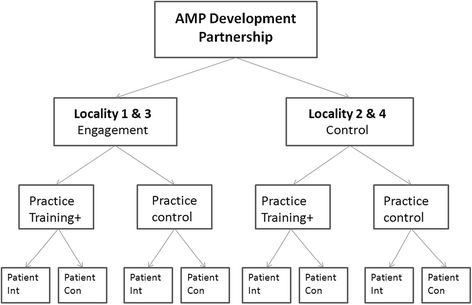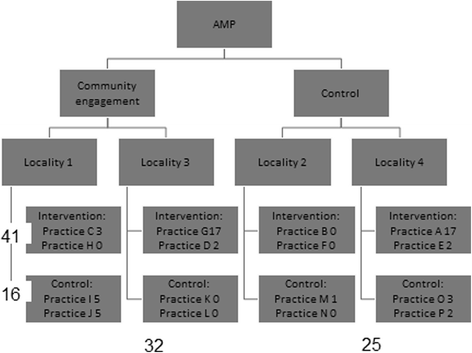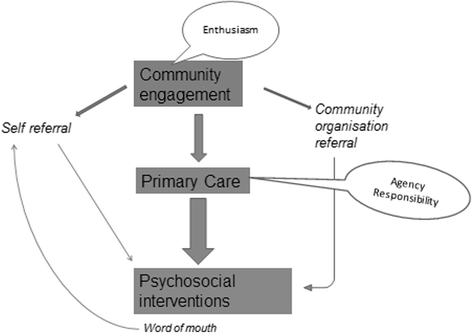Evaluating a complex model designed to increase access to high quality primary mental health care for under-served groups: a multi-method study
- PMID: 26883118
- PMCID: PMC4756439
- DOI: 10.1186/s12913-016-1298-5
Evaluating a complex model designed to increase access to high quality primary mental health care for under-served groups: a multi-method study
Abstract
Background: Many people with mental distress are disadvantaged because care is not available or does not address their needs. In order to increase access to high quality primary mental health care for under-served groups, we created a model of care with three discrete elements: community engagement, primary care training and tailored wellbeing interventions. We have previously demonstrated the individual impact of each element of the model. Here we assess the effectiveness of the combined model in increasing access to and improving the quality of primary mental health care. We test the assumptions that access to the wellbeing interventions is increased by the presence of community engagement and primary care training; and that quality of primary mental health care is increased by the presence of community engagement and the wellbeing interventions.
Methods: We implemented the model in four under-served localities in North-West England, focusing on older people and minority ethnic populations. Using a quasi-experimental design with no-intervention comparators, we gathered a combination of quantitative and qualitative information. Quantitative information, including referral and recruitment rates for the wellbeing interventions, and practice referrals to mental health services, was analysed descriptively. Qualitative information derived from interview and focus group responses to topic guides from more than 110 participants. Framework analysis was used to generate findings from the qualitative data.
Results: Access to the wellbeing interventions was associated with the presence of the community engagement and the primary care training elements. Referrals to the wellbeing interventions were associated with community engagement, while recruitment was associated with primary care training. Qualitative data suggested that the mechanisms underlying these associations were increased awareness and sense of agency. The quality of primary mental health care was enhanced by information gained from our community mapping activities, and by the offer of access to the wellbeing interventions. There were variable benefits from health practitioner participation in community consultative groups. We also found that participation in the wellbeing interventions led to increased community engagement.
Conclusions: We explored the interactions between elements of a multilevel intervention and identified important associations and underlying mechanisms. Further research is needed to test the generalisability of the model.
Trial registration: Current Controlled Trials, reference ISRCTN68572159 . Registered 25 February 2013.
Figures





Similar articles
-
Increasing equity of access to high-quality mental health services in primary care: a mixed-methods study.Southampton (UK): NIHR Journals Library; 2013 Oct. Southampton (UK): NIHR Journals Library; 2013 Oct. PMID: 27466664 Free Books & Documents. Review.
-
Improving access to mental health care in an Orthodox Jewish community: a critical reflection upon the accommodation of otherness.BMC Health Serv Res. 2017 Aug 14;17(1):557. doi: 10.1186/s12913-017-2509-4. BMC Health Serv Res. 2017. PMID: 28806946 Free PMC article.
-
Development and evaluation of culturally sensitive psychosocial interventions for under-served people in primary care.BMC Psychiatry. 2014 Aug 1;14:217. doi: 10.1186/s12888-014-0217-8. BMC Psychiatry. 2014. PMID: 25085447 Free PMC article. Clinical Trial.
-
Impact of summer programmes on the outcomes of disadvantaged or 'at risk' young people: A systematic review.Campbell Syst Rev. 2024 Jun 13;20(2):e1406. doi: 10.1002/cl2.1406. eCollection 2024 Jun. Campbell Syst Rev. 2024. PMID: 38873396 Free PMC article. Review.
-
Beyond the black stump: rapid reviews of health research issues affecting regional, rural and remote Australia.Med J Aust. 2020 Dec;213 Suppl 11:S3-S32.e1. doi: 10.5694/mja2.50881. Med J Aust. 2020. PMID: 33314144
Cited by
-
Interventions to improve the mental health or mental well-being of migrants and ethnic minority groups in Europe: A scoping review.Glob Ment Health (Camb). 2023 Apr 20;10:e23. doi: 10.1017/gmh.2023.15. eCollection 2023. Glob Ment Health (Camb). 2023. PMID: 37854435 Free PMC article.
-
Designing and Assessing Multilevel Interventions to Improve Minority Health and Reduce Health Disparities.Am J Public Health. 2019 Jan;109(S1):S86-S93. doi: 10.2105/AJPH.2018.304730. Am J Public Health. 2019. PMID: 30699029 Free PMC article.
-
Engaging in Late-Life Mental Health Research: a Narrative Review of Challenges to Participation.Curr Treat Options Psychiatry. 2020;7(3):317-336. doi: 10.1007/s40501-020-00217-9. Epub 2020 May 22. Curr Treat Options Psychiatry. 2020. PMID: 32837830 Free PMC article. Review.
-
Suffering and hope: Helen Lester Memorial Lecture 2016.BJGP Open. 2017 Feb 15;1(1):bjgpopen17X100605. doi: 10.3399/bjgpopen17X100605. BJGP Open. 2017. PMID: 30564641 Free PMC article. No abstract available.
-
Factors contributing to the recognition of anxiety and depression in general practice.BMC Fam Pract. 2018 Jun 23;19(1):99. doi: 10.1186/s12875-018-0784-8. BMC Fam Pract. 2018. PMID: 29935537 Free PMC article.
References
-
- National Institute for Health and Clinical Excellence . Depression: Management of Depression in Primary and Secondary Care (Update). Clinical Guideline 90. London: National Institute for Health and Clinical Excellence; 2009.
-
- Mitchell J, Trangle M, Degnan B, Gabert T, Haight B, Kessler D, Mack N, Mallen E, Novak H, Rossmiller D, Setterlund L, Somers K, Valentino N, Vincent S. Institute for Clinical Systems Improvement. Adult Depression in Primary Care. Updated September 2013. 2013. www.icsi.org/_asset/fnhdm3/Depr-Interactive0512b.pdf. Accessed 21 January 2015.
-
- Kovandžić M, Chew-Graham C, Reeve J, Edwards S, Peters S, Edge D, Aseem S, Gask L, Dowrick C. Access to primary mental health care for hard-to-reach groups: from 'silent suffering' to 'making it work'. Soc Sci Med. 2011;72:763–72. - PubMed
-
- Social Exclusion Unit . Mental health and social exclusion. London: Office of the Deputy Prime Minister; 2004.
Publication types
MeSH terms
Associated data
Grants and funding
LinkOut - more resources
Full Text Sources
Other Literature Sources
Medical

